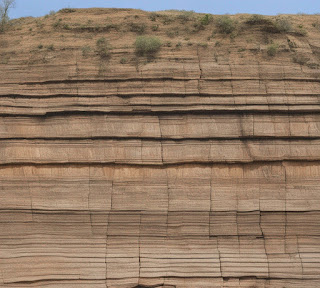India's Geological Timeline: Indian stratigraphy is a captivating field of geology that unravels the geological history of the Indian subcontinent through the study of rock layers and sedimentary sequences.
With a diverse and complex geological heritage, India's stratigraphy provides a unique window into the ancient past, stretching back millions of years.
In this blog post, we will embark on a journey through the fascinating world of Indian stratigraphy, exploring the major geological formations, key events, and the rich tapestry of life that has thrived on this land throughout the ages.

The Geological Timeline of India:
India's geological timeline spans billions of years and is divided into distinct eons, eras, and periods. The earliest known rocks in India are part of the Archean Craton, dating back over 3.5 billion years. The subsequent geological periods, such as the Proterozoic Eon and Phanerozoic Eon, are characterized by significant geological and biological events that have shaped the landscape we see today.
The Precambrian Era: The Ancient Foundations:
The Precambrian Era is the earliest part of India's geological history, covering approximately 88% of the country's land area. During this era, the Archean and Proterozoic periods witnessed the formation of the Indian Shield, a vast and stable continental region. The rocks of the Dharwar Supergroup and the Vindhyan Super group are prominent features representing this era. The Precambrian rocks are essential as they hold vital clues to the Earth's early geological and evolutionary processes.
The Palaeozoic Era: Emergence of Life:
The Palaeozoic Era marks the emergence of complex life forms on Earth. In India, the Palaeozoic is represented by sedimentary rocks like the Gondwana Group, which contains rich fossil assemblages of plants and early tetrapods. These deposits also include valuable coal reserves that continue to play a crucial role in India's energy landscape.

The Mesozoic Era: Age of the Dinosaurs:
The Mesozoic Era is known for the reign of the dinosaurs. During this time, India was part of the supercontinent Gondwana. Fossils of dinosaurs and other prehistoric creatures have been found in the sedimentary rocks of the Kutch Basin, the Lameta Formation, and the Saurashtra region. The splitting of Gondwana eventually led to the drift of the Indian subcontinent, setting the stage for significant geological and paleo geographical changes.
The Cenozoic Era: The Rise of Mammals and the Himalayas:
The Cenozoic Era is the most current part of India's geological history. During this era, India's collision with the Eurasian plate resulted in the uplift of the mighty Himalayan mountain range. The Siwalik Group, characterized by sedimentary rocks and rich fossil assemblages, provides crucial insights into the evolution of mammals, including early primates.
Indian Stratigraphy and Economic Significance:
Indian stratigraphy is of immense economic importance due to its abundant mineral resources. The sedimentary basins in India host vast reserves of coal, oil, natural gas, and valuable minerals like iron ore, limestone, and bauxite. Understanding the geological formations and their depositional environments is critical for sustainable resource management and exploration.
The Impact of Indian Stratigraphy on Paleoclimate and Paleogeography:
Studying Indian stratigraphy allows scientists to reconstruct ancient paleoclimatic conditions and paleo geographical changes. For instance, the Deccan Traps, a large volcanic province in India, are believed to have played a role in the mass extinction event that marked the end of the Cretaceous Period, leading to the demise of the dinosaurs.
Challenges and Future Directions in Indian Stratigraphy:
Despite significant progress in understanding India's geological history, there are still many areas that remain unexplored or poorly understood. Integrating modern geological and geophysical techniques with traditional field-based studies will provide a more comprehensive understanding of India's stratigraphy. Additionally, addressing environmental concerns and protecting valuable geological sites will be crucial for future research and conservation efforts.
Indian stratigraphy offers an enthralling glimpse into the geological tapestry of the subcontinent, spanning billions of years. From the ancient rocks of the Archean Craton to the uplifting of the Himalayas, the stratigraphic layers of India narrate a captivating story of the Earth's evolution and the life forms that have thrived through the ages. The study of Indian stratigraphy not only sheds light on the country's geological history but also plays a crucial role in resource management, understanding paleoclimate, and predicting geological hazards. As technology and scientific methodologies continue to advance, the pursuit of Indian stratigraphy promises to unearth even more intriguing revelations about the Earth's past and the interconnectedness of life on our dynamic planet Google Search Engine. Earth Ancient
Know also Optical Minerology
Visit Official Home Page





0 Comments